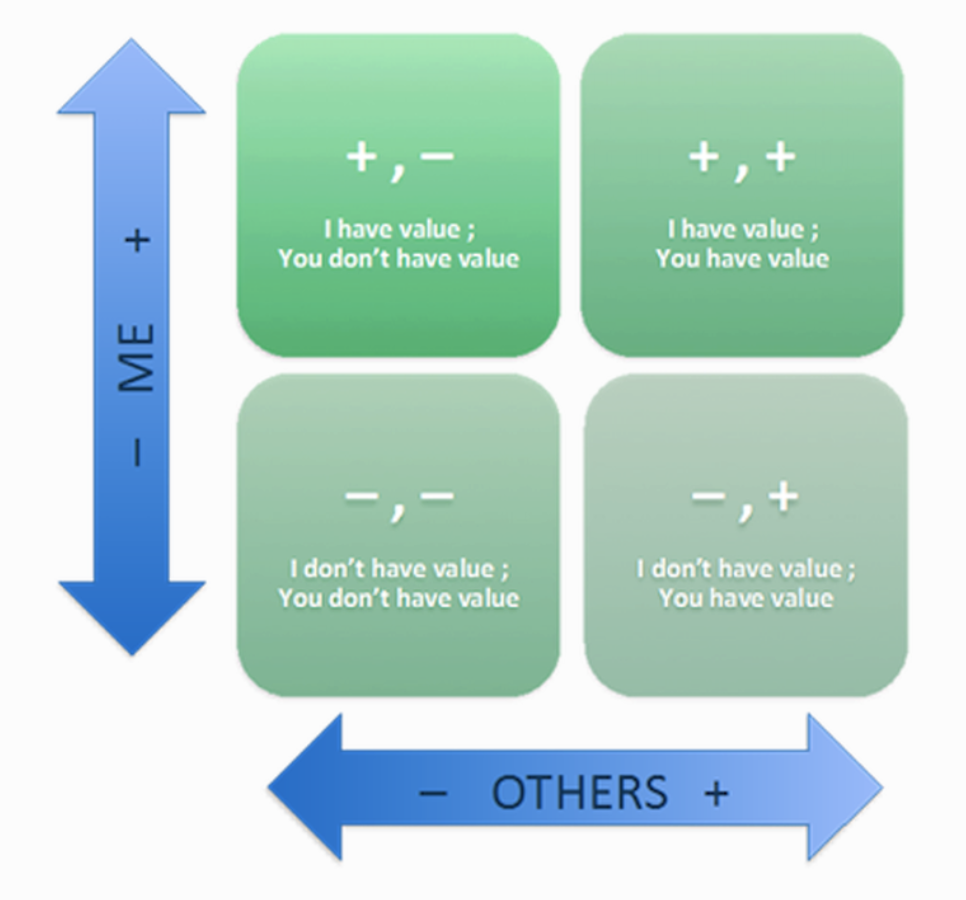Expanding On The Understanding Of Mindset

In the 1960s, Dr. Thomas A. Harris wrote a revolutionary book, I’m OK-You’re OK, that explored the concepts of four major “life positions.” Over 50 years later, those amazing major concepts he explained are still being talked about and explored extensively in multiple fields.
There are variations on the original themes, but they all owe their origins to Dr. Harris. I’d like to share with you my take on these interesting and helpful ideas.
You can think of these ideas as being particular points along a horizontal axis and a vertical axis. The horizontal axis ranges from Minus Others to Plus Others, with the vertical axis ranging from Minus Me to Plus Me. The four quadrants consist of +,-; +,+; -,+; -,- if looked at in a clockwise fashion.
Thus, we end with a graph that looks like this:

The sought-after state is the +,+ where both participants or both groups are working together equally without any power deficits or negative emotions. In two of the other states, someone is operating from a fragile, less ideal position. In one state, both parties are working from a place of weakness and/or anger.
In the ideal state, both parties are coming from a place of confidence, cooperation, courage, creativity, and care.
It’s important to understand that the optimal state is challenging to maintain. For human beings, there is the ongoing possibility (and probability) of multiple state changes taking place in very short spans of time. Humans are capable (and likely) to experience multiple life positions just seconds apart.
The life positions change constantly throughout a conversation, a meeting and a day. As the stimuli, input, tones of voice, physical expressions and subject matter change with rapidity, the mindsets change nanoseconds behind. This results in multiple, sometimes conflicting chemical cascades in the brain.
It has been scientifically explained that neurochemical changes in the brain accompany specific life positions being utilized. The correlation between stressful mindsets and the production of cortisol in the amygdala results in brain “lockdown” of executive function and triggers the primitive flight-or-fight reaction. Also, prolonged periods of stressful events can raise cortisol levels.
Conversely, it has been shown that positive mindsets and the production of oxytocin result in high-level brain function and feelings of social inclusion and trust. Oxytocin can decrease anxiety and protect against stress, but laughing can lower cortisol levels.
Knowing that these chemical reactions are occurring and that they can be controlled by one’s mental state, it can be useful to remember the acronym STOP.
S stands for step back. It is important to pause, breathe and reflect.
T is for think. Helpful questions are:
• What is my life position right now?
• Is this position useful or not useful?
• What do I want?
The next letter, O, is for orientating. What is in your power to do to change your mood?
The P is simply to proceed when you have decided your best course of action.
It can be beneficial to contemplate the scenarios in your life and how you interact in them. Do you tend to fall into an “I don’t have value, but you have value” mindset when dealing with an authority figure? Do you often find yourself in an “I have value, but you don’t have value” position when dealing with a difficult co-worker who frustrates you? These situations are more common in the business world than you might think.
The truth is that you have the power to make the changes necessary to choose to operate in the “I have value, and you have value” life position most of the time. It may be challenging at first, but you’ll quickly find with a bit of conscious effort, you can improve relationships with coworkers, friends, and family.
This article has previously been featured on Forbes
